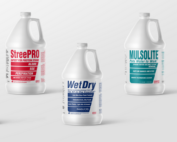
7 Tips to Prevent Garment Graying and Keep Whites Bright in Drycleaning
In today’s highly competitive drycleaning industry, one of the most important factors determining the success of your business is ensuring customer satisfaction. That satisfaction is often directly tied to delivering bright whites and maintaining quality standards across garments. Garment graying is a widespread issue that can lead to customer dissatisfaction and damaged reputations. The Drycleaning & Laundry Institute (DLI) has consistently highlighted redeposition—commonly referred to as garment graying—as a frequent consumer complaint. But fear not, because we’ve compiled practical insights and tips to help your garments stay white and your customers stay happy.
1. Garment Classification
- Are you sorting each load according to color?
- Are you sorting each load by garment weight?
- Are you sorting each load by the degree of soiling?
Keeping light and dark garments separate is essential to avoid cross-color contamination. Separating lightweight and heavyweight garments also ensures that fabrics with varying needs aren't mixed. Finally, heavily soiled clothes should always be cleaned in separate loads to avoid spreading dirt to other garments.
2. Do Not Overload Your Machine
- Load normal garments at 80% of the recommended capacity.
- Bulky items should fill the wheel about three-quarters full.
Overloading machines is a common problem, especially with solvents like hydrocarbon and silicone that require longer process times. To ensure proper cleaning, follow these guidelines and maintain consistent, high-quality results.
3. Check the Solvent in Your Work Tank Before Each Load
- Make sure there's no dye present in the solvent.
- Ensure sufficient solvent levels are maintained. Aim for 1 gallon per pound, but ½ to ¾ gallon per pound is more achievable.
By regularly checking for dye or debris in your solvent, you can prevent potential redeposition issues that cause garments to gray.
4. Make Sure Your Filtered Cleaning Cycle is Long Enough
- Normal soiling in perc requires 12 minutes; in hydrocarbon, 20 minutes.
- Heavy soiling in perc needs 15 minutes; in hydrocarbon, 25 minutes.
To prevent graying and redeposition, ensure that your cleaning cycles are long enough for the solvent to work effectively.
5. Check Your Solvent Flow Daily
- A fill time of 45 seconds to 1 minute 15 seconds through the filter is optimal.
Modern machines often complicate checking solvent flow due to design restrictions. If direct monitoring isn't possible, change filters when pressure increases or solvent color deteriorates. Follow manufacturer recommendations for spinning disk filters.
6. Use Detergent at the Manufacturer's Recommended Dosage
- For injection detergents, ensure proper amounts are being injected.
- For charge detergents, check the charge regularly with available test kits.
- Consult your manufacturer's representative on proper detergent use.
Excess or insufficient detergent can lead to graying and redeposition. Maintaining the right levels ensures optimal cleaning results.
7. Pre-Spotted Garments
- Ensure moisture is removed or treated with a leveling agent like Sofspot or Spotless HC.
For garments pre-treated with wet stain removal agents, drying moisture or neutralizing with a leveling agent helps prevent issues during cleaning.
Conclusion
By understanding the core principles of garment classification, machine loading, solvent checks, cleaning cycles, solvent flow, detergent usage, and pre-spotting practices, you can minimize the risk of garment graying. This will not only help maintain your reputation for quality but also keep your customers loyal and their whites bright.



